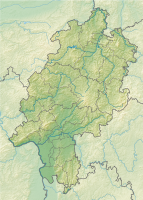Faulbruch near Erzhausen
|
NSG Faulbruch near Erzhausen
|
||
|
Wet meadow in the Faulbruch between Erzhausen and Wixhausen |
||
| location | Erzhausen | |
| surface | 65.75 hectares | |
| Identifier | 1432028 | |
| WDPA ID | 318383 | |
| Natura 2000 ID | DE-6017-306 | |
| FFH area | 15.2 ha | |
| Geographical location | 49 ° 57 ' N , 8 ° 40' E | |
|
|
||
| Setup date | August 2, 2001 | |
The Faulbruch near Erzhausen is a nature reserve (NSG identification 1432028) on the boundaries of the communities of Erzhausen and Egelsbach in southern Hesse . It consists of three neighboring areas. A sub-area in the south-east is also under protection as the FFH area Faulbruch von Erzhausen (identifier DE-6017-306).
Faulbruch nature reserve
The nature reserve was designated by ordinance of August 2, 2001 and covers an area of 65.75 hectares. The Faulbruch (historically also: the Faulbruch) is a forest and meadow area on the eastern edge of Erzhausen. Most of the Faulbruch is to the east of the Frankfurt – Darmstadt railway line ; a small part is west of the railway line. The northern part belongs to Egelsbach . The Faulbruch is cut through by the district road 167. There are also several forest paths on the area .
Geomorphology and ecology
The Faulbruch is a species-rich, submontane boron grass pasture on silicate soil. In addition, there are marsh grass meadows on calcareous, peaty and clayey-silty soil ( Molinion caeruleae ).
The Faulbruch was probably originally a deciduous forest ( Alnetea glutinosae ) made up almost entirely of black alder swamp forest and gray willow bushes . The Faulbruch is located on a ground with high standing, little fluctuating, but slowly moving, base-rich groundwater . The bases that are brought in neutralize the acids produced by anaerobic soil organisms and thus enable the organic plant remains to be largely decomposed by bacteria and earthworms . The several centimeters thick quarry forest peat (quarry forest peat) made of wood and cone remains hardly shows any plant structures. In spring, before the start of the vegetation period, flooding and prolonged waterlogging of the Faulbruch can occur. The subsequent, at least superficial desiccation of the soil is an essential prerequisite for the settlement of the shallow-rooted black alder in terms of nitrogen mineralization and oxygen supply.
In the quarry forest itself, the high groundwater level allows the undergrowth of swamp plants to appear in the wet meadows and reeds instead of typical deciduous forest types. From today's point of view, the trees are worthless in terms of forestry. The Faulbruch is partially drained; whereby part of the humid biotope , which is valuable for nature conservation , is lost.
The Faulbruch today
The Faulbruch is no longer a pure black alder break forest. Much of the area is similar to a partially drained mixed forest with forest meadows . It consists of: (As of 2015.)
- Acid beech forests 35.1%
- Quarry and swamp forests 18.1%
- Deciduous forests strongly characterized by forest 1.1%
- Other coniferous forests 20.3%
- Mixed forests 4.3%
- Floodplains and forest 0.3%
- Forest edges 1.3%
- Woods in moist to wet locations 0.7%
- Temporary waters and pools 0.2%
- Reeds 0.4%
- Wet fallow land and tall herbaceous vegetation 0.2%
- Grassland in fresh locations 0.4%
- Grassland moist to wet locations 10.3%
- Grassland in alternately humid locations 4.3%
- Other grassland stocks 2.2%
- Bristle grass lawn 0.6%
- Persistent ruderal corridors in fresh to moist locations 0.2%
Waters
The Faulbruch is drained via the following bodies of water:
- Hegbach (also: Heegbach )
- Bach of Erzhausen (also: Gänswiesenbach )
- Wildgraben (also: Wilder Graben )
Forest meadows
There are the following forest meadows in the Faulbruch nature reserve:
- Bauer Wiese ( 49 ° 57 '3.6 " N , 8 ° 39' 30.6" O )
- Sauwiese ( 49 ° 56 ′ 55.7 ″ N , 8 ° 39 ′ 19.8 ″ E )
- Faulbruchwiese ( 49 ° 56 ′ 44.5 ″ N , 8 ° 39 ′ 13 ″ E )
fauna
Rare animals in Faulbruch are:
- The Russian bear butterfly species ( Euplagia quadripunctaria )
- until 2001: Dark blue ant blue ( Maculinea nausithous )
flora
Rare plants in Faulbruch are:
Toponyms
The following historical forms of name are known:
- 1497: in the lazy break
- 1658: in the fauhl break
- 1767: in the lazy break
- 19th century: The Faulbruch
- copial 20th century
- copial 21st century
etymology
- Faul: Too Old High German (ahd.) Fûl and Middle High German (mhd.) Vûl, lazy, rotten. They are barren, swampy parcels of land.
- Break: To ahd./mhd. bruoch st. NM "Bog soil, swamp". The names are reminiscent of damp meadow grounds.
See also
- List of nature reserves in the Darmstadt-Dieburg district
- List of nature reserves in the Offenbach district
- List of FFH areas in Hessen
Web links
Individual evidence
- ↑ nature reserves. In: Kreis-offenbach.de. Retrieved September 20, 2018 .
- ↑ Map of the nature reserve. natureg.hessen.de, accessed on July 16, 2020 .
- ↑ Ordinance on the “Faulbruch bei Erzhausen” nature reserve of August 2, 2001. (PDF) State Gazette for the State of Hesse 35/2001, p. 3210, no. 771, accessed on July 16, 2020 .
- ↑ a b c Natura2000 regulation , regional council Darmstadt, rpda.de, accessed on August 16, 2019.
- ↑ a b c d Management plan for the FFH area 6017-306 "Faulbruch von Erzhausen" and the NSG "Faulbruch bei Erzhausen" February 25, 2015, (PDF), natureg.hessen.de, accessed on August 16, 2019.
- ↑ City Atlas Darmstadt and Surroundings, Official City Map Darmstadt, Surveying Office of the City of Science Darmstadt, Cartography Department, 2016, p. 11.



